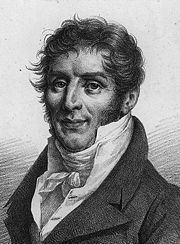
André-Jean-François-Marie Brochant de Villiers
Encyclopedia

France
The French Republic , The French Republic , The French Republic , (commonly known as France , is a unitary semi-presidential republic in Western Europe with several overseas territories and islands located on other continents and in the Indian, Pacific, and Atlantic oceans. Metropolitan France...
mineralogist and geologist
Geologist
A geologist is a scientist who studies the solid and liquid matter that constitutes the Earth as well as the processes and history that has shaped it. Geologists usually engage in studying geology. Geologists, studying more of an applied science than a theoretical one, must approach Geology using...
.
He was born at the Château de Villiers, near Mantes-la-Ville
Mantes-la-Ville
Mantes-la-Ville is a commune in the Yvelines department in the Île-de-France region in north-central France. It is located in the western suburbs of Paris from the center....
. After studying at the École Polytechnique
École Polytechnique
The École Polytechnique is a state-run institution of higher education and research in Palaiseau, Essonne, France, near Paris. Polytechnique is renowned for its four year undergraduate/graduate Master's program...
, Paris, he was in 1794 the first pupil admitted to the École des Mines. In 1804 he was appointed professor of geology and mineralogy in the École des Mines, which had been temporarily transferred to Pezay in Savoy
Savoy
Savoy is a region of France. It comprises roughly the territory of the Western Alps situated between Lake Geneva in the north and Monaco and the Mediterranean coast in the south....
, and he returned with the school to Paris in 1815. Later on he became inspector general of mines and a member of the Academy of Sciences
Academy of Sciences
An Academy of Sciences is a national academy or another learned society dedicated to sciences.In non-English speaking countries, the range of academic fields of the members of a national Academy of Science often includes fields which would not normally be classed as "science" in English...
.
He investigated the transition strata of the Tarantaise, wrote on the position of the granite
Granite
Granite is a common and widely occurring type of intrusive, felsic, igneous rock. Granite usually has a medium- to coarse-grained texture. Occasionally some individual crystals are larger than the groundmass, in which case the texture is known as porphyritic. A granitic rock with a porphyritic...
rocks of Mont Blanc
Mont Blanc
Mont Blanc or Monte Bianco , meaning "White Mountain", is the highest mountain in the Alps, Western Europe and the European Union. It rises above sea level and is ranked 11th in the world in topographic prominence...
, and on the lead minerals of Derbyshire
Derbyshire
Derbyshire is a county in the East Midlands of England. A substantial portion of the Peak District National Park lies within Derbyshire. The northern part of Derbyshire overlaps with the Pennines, a famous chain of hills and mountains. The county contains within its boundary of approx...
and Cumberland. He was charged with overseeing the construction of the geological map of France, undertaken by his pupils Dufrénoy
Ours-Pierre-Armand Petit-Dufrénoy
Ours-Pierre-Armand Petit-Dufrénoy was a French geologist and mineralogist.He was born at Sevran, in the département of Seine-et-Oise. After leaving the Imperial Lyceum in 1811, he studied until 1813 at the École Polytechnique, and then entered the Corps des Mines...
and Elie de Beaumont
Jean-Baptiste Élie de Beaumont
Jean-Baptiste Armand Louis Léonce Élie de Beaumont was a French geologist.-Biography:Élie de Beaumont was born at Canon, in Calvados...
.
His publications include Traité élémentaire de minéralogie (2 vols., 1801–1802; 2nd ed., 1808), and Traité abrégé de cristallographie (Paris, 1818).

